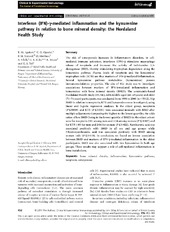| dc.contributor.author | Apalset, Ellen M. | en_US |
| dc.contributor.author | Gjesdal, Clara Gram | en_US |
| dc.contributor.author | Ueland, Per Magne | en_US |
| dc.contributor.author | Midttun, Øyvind | en_US |
| dc.contributor.author | Ulvik, Arve | en_US |
| dc.contributor.author | Eide, Geir Egil | en_US |
| dc.contributor.author | Meyer, Klaus | en_US |
| dc.contributor.author | Tell, Grethe Seppola | en_US |
| dc.date.accessioned | 2014-12-22T07:26:45Z | |
| dc.date.available | 2014-12-22T07:26:45Z | |
| dc.date.issued | 2014-04-24 | eng |
| dc.identifier.issn | 0009-9104 | |
| dc.identifier.uri | https://hdl.handle.net/1956/9004 | |
| dc.description.abstract | The risk of osteoporosis increases in inflammatory disorders. In cell-mediated immune activation, interferon (IFN)-γ stimulates macrophage release of neopterin and increases the activity of indoleamine 2,3-dioxygenase (IDO), thereby stimulating tryptophan degradation along the kynurenine pathway. Plasma levels of neopterin and the kynurenine/tryptophan ratio (KTR) are thus markers of IFN-γ-mediated inflammation. Several kynurenine pathway metabolites (kynurenines) possess immunomodulatory properties. The aim of this study was to investigate associations between markers of IFN-γ-mediated inflammation and kynurenines with bone mineral density (BMD). The community-based Hordaland Health Study (HUSK), with middle-aged (46–49 years) and older (71–74 years) participants, was conducted from 1998 to 2000 (n = 5312). Hip BMD in relation to neopterin, KTR and kynurenines were investigated, using linear and logistic regression analyses. In the oldest group, neopterin (P ≤ 0·019) and KTR (P ≤ 0·001) were associated inversely with BMD after multiple adjustment. Comparing the highest to the lowest quartiles, the odds ratios of low BMD (being in the lowest quintile of BMD) in the oldest cohort were for neopterin 2·01 among men and 2·34 among women (P ≤ 0·007) and for KTR 1·80 for men and 2·04 for women (P ≤ 0·022). Xanthurenic acid was associated positively with BMD in all sex and age groups while 3-hydroxyanthranilic acid was associated positively with BMD among women only (P ≤ 0·010). In conclusion, we found an inverse association between BMD and markers of IFN-γ-mediated inflammation in the oldest participants. BMD was also associated with two kynurenines in both age groups. These results may support a role of cell-mediated inflammation in bone metabolism. | en_US |
| dc.language.iso | eng | eng |
| dc.publisher | Wiley | eng |
| dc.publisher | British Society for Immunology | eng |
| dc.rights | Attribution-NonCommercial-NoDerivs CC BY-NC-ND | eng |
| dc.rights.uri | http://creativecommons.org/licenses/by-nc-nd/3.0/ | eng |
| dc.subject | bone mineral density | eng |
| dc.subject | Inflammation | eng |
| dc.subject | Kynurenine pathway | eng |
| dc.subject | Neopterin | eng |
| dc.subject | Osteoporosis | eng |
| dc.title | Interferon (IFN)-γ-mediated inflammation and the kynurenine pathway in relation to bone mineral density: the Hordaland Health Study | en_US |
| dc.type | Peer reviewed | |
| dc.type | Journal article | |
| dc.description.version | publishedVersion | en_US |
| dc.rights.holder | Copyright 2014 The Authors | |
| dc.identifier.doi | https://doi.org/10.1111/cei.12288 | |
| dc.identifier.cristin | 1161435 | |
| dc.source.journal | Clinical & Experimental Immunology | |
| dc.source.40 | 176 | |
| dc.source.14 | 3 | |
| dc.source.pagenumber | 452-460 | |

